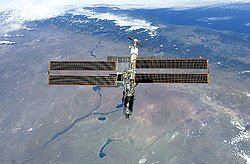| From competition to partnership and cooperation |
|
International Space Station
International Projects
|

|

|
| Photo |
Description |

Today the International Space Station (ISS) project is the single largest international effort. Financial and technological resources and experience of a number of countries including the United States, Russia, Canada, Italy, Japan and the European Space Agency (ESA) member states have been pooled to make this project a reality.ISS Russian Segment Modules: Main Areas of Commercial Applications
During the entire history of Russian manned space station projects, it was the KhSC shopfloor that gave birth to all orbital stations (including Salyut, Mir and Almaz (Diamond)), heavy modules to be docked to space stations in orbit, and three-seat reentry vehicles. The few early successful missions have opened the way for creating long-term manned space stations. Injection into orbit and operation of manned space vehicles have made continuous human operations in space possible.
Work aimed at defining the ISS configuration, with Russia’s involvement, started in August 1993. And the final configuration (that included Zarya (’Dawn’), the Russian power module, as the initial component of the station) was adopted, based on KhSC proposals, at a meeting of representatives of the Russian Space Agency (RSA), NASA, KhSC and Energia in October 1993. Russia’s involvement in the ISS project is the result of Russia’s vast experience in building piloted orbital systems.
An intergovernmental agreement providing for Russia’s participation in the construction of the ISS as well as the United States’ involvement in the Russian MIR Project was signed in early September 1993.
A team of experts from NASA and the U.S. industry visited the Khrunichev Space Center in September 1993 to get a better understanding of KhSC’s capabilities as a potential participant of the ISS project.
Representatives of NASA and Boeing met with KhSC and Energia at the RSA’s premises on October 4, 1993 to accept KhSC’s proposal that the Zarya power module (also known as FGB) be the first ISS building block. FGB is similar to the heavy supply ships and space station modules developed by KhSC over more than two decades.
On February 5, 1995, NASA and RSA signed the Protocol on Parties’ Contribution to the Launch of the ISS First Module. This launch was designated as Flight 1A/R for the First American-Russian Flight. Subject to this Protocol, RSA shall provide a Proton LV to launch Zarya, and simulators to train the future crews to operate this module. Additionally, RSA shall control and maintain Zarya throughout its orbital life.
Two major changes in the Zarya design were suggested by the customer (i.e., NASA and Boeing) in the development phase and these modifications have significantly improved the ISS performance in its initial assembly phase.
The Zarya module was successfully placed in orbit by a Proton LV on November 20, 1998.
The Service Module, which was being developed and designed by Khrunichev virtually in parallel with the Zarya block, is a considerably modified version of the Mir core module. The Service Module was the third vehicle (following FGB and Unity, a U.S. module) to be placed in orbit and attached to the FGB/Unity assembly.
A Proton K launcher carrying Zvezda (Star), an ISS module, was successfully launched from Baikonyr at 0856 Moscow time, July 12, 2000 to insert this module in the parking orbit.
Zvezda was then successfully docked to the Zarya/Unity assembly on July 26, 2000.
While KhSC were developing Zarya a decision was made by KhSC managers in 1995 to finance and build FGB2, a Zarya backup, that might eventually be incorporated in the Russian segment of the ISS. In August 2001, the Russian Aerospace Agency (’Rosavaikosmos’) approved KhSC’s proposal that FGB2 be integrated in the ISS Russian segment as a multi-functional module to perform some of the functions initially assigned to the Science and Power Platform and/or to the Universal Docking Module. (Work on the latter two projects was suspended because of cuttings in governmental financing.)
Inclusion of FGB2 in the Russian segment will enable Russia to fulfill its obligations while increasing the Russian share in the ISS. Additionally, the operation of FGB2 will make it possible (1) to proceed with the Federal Research Program and (2) to use the module’s resource on a commercial basis.
This module has been awarded an international certificate testifying to the module’s ability to operate as part of the ISS for 15 years.
The Khrunichev Center and Rosaviakosmos have been negotiating with major foreign companies the commercial use of the FGB2 resource. An agreement was signed with Boeing in November 2001 outlining major aspects of a joint use of the FGB2 resource provided that Boeing will financially support the module’s upgrades as may be required to achieve this goal.
Contacts:
Program Management:
Phones: 7 (095) 797-62-11, 7 (095) 145-98-40
Fax: 7 (095) 145-93-05
e-mail: [email protected]
|
|
|
|